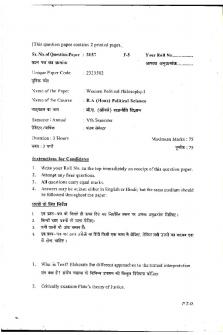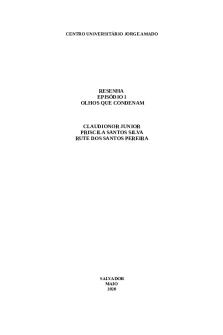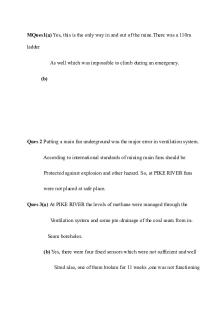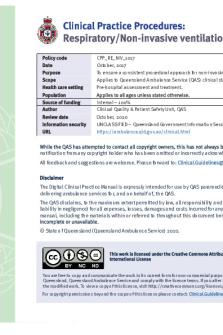CPP Non invasive ventilation CPAP PDF

| Title | CPP Non invasive ventilation CPAP |
|---|---|
| Author | Lateesha McGrath |
| Course | Cardiac and Respiratory Emergencies |
| Institution | University of the Sunshine Coast |
| Pages | 5 |
| File Size | 986.1 KB |
| File Type | |
| Total Downloads | 10 |
| Total Views | 151 |
Summary
Course Coordinator: Dr Lisa Clegg...
Description
Clinical Practice Procedures:
Respiratory/Non-invasive ventilation – CPAP
Policy code Date
CPP_RE_NIV_1017 October, 2017
Scope
To ensure a consistent procedural approach for non-invasive ventilation – CPAP. Applies to Queensland Ambulance Service (QAS) clinical staff.
Health care setting
Pre-hospital assessment and treatment.
Population
Applies to all ages unless stated otherwise.
Purpose
Source of funding Author Review date Information security URL
Internal – 100% Clinical Quality & Patient Safety Unit, QAS October, 2020 UNCLASSIFIED – Queensland Government Information Security Classification Framework. https://ambulance.qld.gov.au/clinical.html
While the QAS has attempted to contact all copyright owners, this has not always been possible. The QAS would welcome
notification from any copyright holder who has been omitted or incorrectly acknowledged. All feedback and suggestions are welcome. Please forward to: [email protected] Disclaimer
The Digital Clinical Practice Manual is expressly intended for use by QAS paramedics when performing duties and delivering ambulance services for, and on behalf of, the QAS. The QAS disclaims, to the maximum extent permitted by law, all responsibility and all liability (including without limitation, liability in negligence) for all expenses, losses, damages and costs incurred for any reason associated with the use of this manual, including the materials within or referred to throughout this document being in any way inaccurate, out of context, incomplete or unavailable.
© State of Queensland (Queensland Ambulance Service) 2020.
This work is licensed under the Creative Commons Attribution-NonCommercial-NoDerivatives V4.0 International License
You are free to copy and communicate the work in its current form for non-commercial purposes, as long as you attribute the State of Queensland, Queensland Ambulance Service and comply with the licence terms. If you alter the work, you may not share or distribute the modified work. To view a copy of this license, visit http://creativecommons.org/licenses/by-nc-nd/4.0/deed.en For copyright permissions beyond the scope of this license please contact: [email protected]
Continuous positive airway pressure (CPAP) is a form of non-invasive ventilation used in spontaneously breathing patients. CPAP reduces the work of breathing, improves pulmonary gas exchange and is associa rates and hospital length of stays.[1] When CPAP is administered to patients with acute oedema the increased intra thoracic pressure lead return (preload), reduced afterload and improved
The o_two®[2] is a single use open CPAP system that uses a vectored flow valve to create additional flow during inspiration nce with expiration. By varying the oxygen flow the rway pressure can be increased or decreased to constant accurate positive airway pressure.
Indications CCP • Acute pulmonary oedema • Severe OR life-threatening asthma ! (only in patients who are unresponsive to 3 x 5 mg continuous salbutamol NEBs) ACP2 • Acute pulmonary oedema
Contraindications • Patients < 16 years • GCS ≤ 8 • Inadequate ventilatory drive • Hypotension (SBP < 90 mmHg) • Pneumothorax • Facial trauma • Epistaxis QUEENSLAND AMBULANCE SERVICE
697
Complications • Aspiration • Gastric distension • Hypotension
Procedure – Non-invasive ventilation – CPAP 1. Place patient in a seated position. 2. Explain procedure to the patient (their understanding and cooperation ! is essential for successful CPAP).
• Corneal drying • Barotrauma
mask ensuring the inner circumference of the dge of the nose, side of the mouth and inferior outh slightly open). d by a red harness connector). d by a blue harness connector).
QUEENSLAND AMBULANCE SERVICE
698
Procedure – Non-invasive ventilation – CPAP 5. Attach the vectored flow valve to the mask and the oxygen tubing, ensuring harness connector remains in place.
8. Position mask on face and secure ! using the supplied harness ! to achieve a comfortable !
6. Connect the oxygen tubing to a ! standard 15 L/min oxygen flow metre. 7. Adjust oxygen flow rate to 8 L/min to generate 5 cm H positive airway pressure (refer to scale on vectored flo
s response to treatment (i.e. respiration rate, ! essure, chest sounds & work of breathing) and increase airway pressure every 3–5 mins (as required) to a ! maximum of 15 cmH2O. 10. If the patient shows evidence of deterioration, discontinue CPAP immediately and treat in accordance with appropriate CPG. QUEENSLAND AMBULANCE SERVICE
699
Additional information • Do not deny the patient oxygen therapy prior to equipment preparation or CPAP procedure. • At no times should the vectored flow inlet of the CPAP ! device be occluded when connected to a pa
o_two® configuration
• The brief interruption of CPAP is authorised administration of sublingual medications as • CPAP O2 concentration: O2 L/min
cm H2O
8
5.0
12
10.0
15
15.0
O2
o_two® CPAP with ! T-piece configuration
QUEENSLAND AMBULANCE SERVICE
700...
Similar Free PDFs

CPP
- 2 Pages

Invasive monitoring plan
- 5 Pages

Bubble cpap makalh
- 20 Pages

Mechanical-ventilation
- 2 Pages

Invasive Species lab
- 3 Pages

Olhos QUE Condenam CPP
- 11 Pages

Ques1 - ventilation system
- 2 Pages

Overview of CPP (CH 1)
- 10 Pages

Mechanical ventilation CM
- 2 Pages

Aplicatii c cpp patrut
- 218 Pages

eclipse cpp tutorial
- 17 Pages
Popular Institutions
- Tinajero National High School - Annex
- Politeknik Caltex Riau
- Yokohama City University
- SGT University
- University of Al-Qadisiyah
- Divine Word College of Vigan
- Techniek College Rotterdam
- Universidade de Santiago
- Universiti Teknologi MARA Cawangan Johor Kampus Pasir Gudang
- Poltekkes Kemenkes Yogyakarta
- Baguio City National High School
- Colegio san marcos
- preparatoria uno
- Centro de Bachillerato Tecnológico Industrial y de Servicios No. 107
- Dalian Maritime University
- Quang Trung Secondary School
- Colegio Tecnológico en Informática
- Corporación Regional de Educación Superior
- Grupo CEDVA
- Dar Al Uloom University
- Centro de Estudios Preuniversitarios de la Universidad Nacional de Ingeniería
- 上智大学
- Aakash International School, Nuna Majara
- San Felipe Neri Catholic School
- Kang Chiao International School - New Taipei City
- Misamis Occidental National High School
- Institución Educativa Escuela Normal Juan Ladrilleros
- Kolehiyo ng Pantukan
- Batanes State College
- Instituto Continental
- Sekolah Menengah Kejuruan Kesehatan Kaltara (Tarakan)
- Colegio de La Inmaculada Concepcion - Cebu




